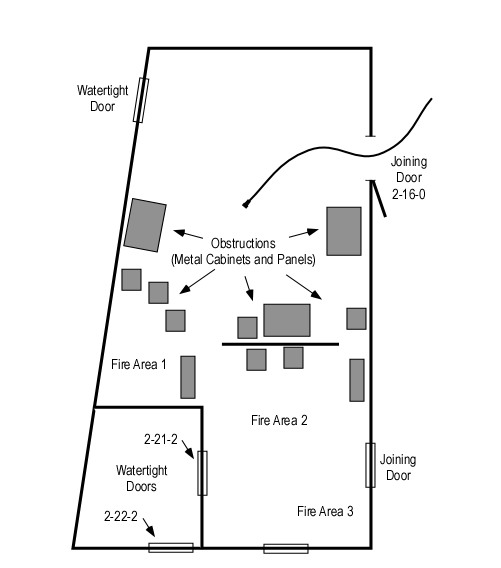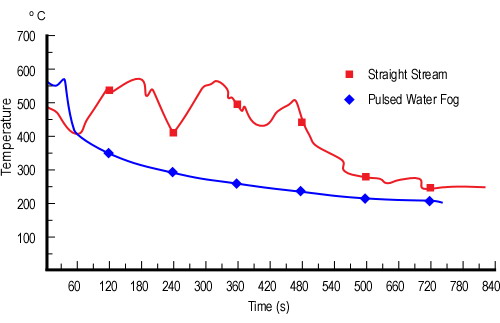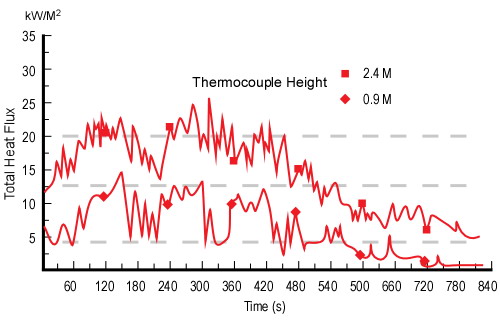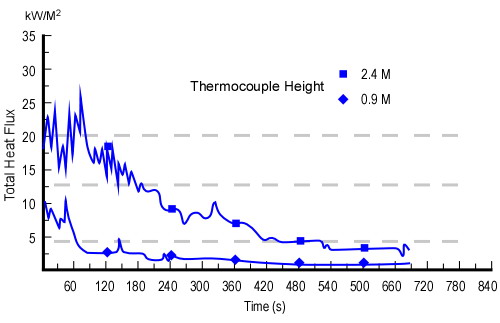Shielded Fires
Fire control and extinguishment is a fairly straightforward process when water can be applied directly to the burning fuel. In the case of burning ordinary combustibles, the energy required to heat the water to its boiling point and convert it to steam cannot be used to continue the process of pyrolysis and lowers fuel temperature to the point where the fire goes out.
However, this process is complicated when the fire is shielded from direct application of water. Assuming that an offensive strategy is appropriate, there are several options for attacking a shielded fire: 1) Make an indirect attack from the exterior (assuming you can access the involved compartment(s) from an exterior location) or 2) Move inside the building to a point inside the building where a an indirect attack can be made from outside the involved compartment(s), or 3) Move inside to a location where a direct attack can be initiated.
When adequate resources are available offensive attack from the interior addresses both life safety and fire control priorities. Proper hoseline placement and coordination of fire control and ventilation tactics protects civilian occupants and provides a safer work environment for firefighters.
The Ongoing Debate
The topic of fire stream selection (fog versus straight or solid stream) likely generates more energy than a fully developed compartment fire. Firefighters bring a great deal of passion based on experience, knowledge, and ignorance to the discussion.
There is not a single answer to the question of which type of fire steam is best. Fog and straight or solid streams have different performance characteristics and are best suited for different applications. Keep in mind that:
- An effective fire stream puts the appropriate amount of water in the right form and right location to achieve the desired result.
- An efficient fire stream accomplishes this with the smallest volume of water and least water damage.
Understanding the effectiveness and efficiency of fire stream application requires both qualitative and quantitative evidence. Firefighters can observe the effects of fire stream application and make a judgment as to effectiveness and efficiency. However, this understanding can be deepened by scientific examination that measures the impact of fire stream application methods.
US Navy Research
In 1994, the United States Navy conducted a series of tests to investigate the aggressive use of water fog for shipboard firefighting (Scheffey, Siegmann, Toomey, Williams, & Farley, 1997). Prior to this time, shipboard firefighting either involved direct attack with a straight stream or narrow fog pattern or indirect attack from outside the involved compartment. This series of tests compared the use of pulsed application of a medium (60o) fog pattern with use of a straight stream in controlling shielded fires and fire conditions involving high temperature and thick smoke conditions that impeded location of the seat of the fire.
The conditions (heat, smoke, and fire gases) associated with these fire scenarios typically does not prevent initial entry into the fire compartment. However, the extra time that it takes to maneuver within a space to locate and attack the seat of the fire does present a significant threat, primarily due to the stage of the fire. Uncontrolled, these fires may continue grow rapidly, potentially resulting in flashover conditions. This is particularly true where the fire is ventilation limited…and entry by the attack team introduces additional air [emphasis added].
While the Navy is concerned with shipboard firefighting, ventilation controlled, shielded fires are commonly encountered by structural firefighters as well.
Test Conditions
The tests were conducted on the ex-USS Shadwell, the Navy’s full-scale damage control research and development platform and involved several different fire scenarios. This post will examine tests involving Fire Threat 1, a growth stage fire involving multiple fuel packages within a compartment to create a well developed growth stage fire approaching flashover (upper layer temperatures in the range of 400o-600o C (752o-1152o F)). In addition, obstructions were placed to preclude the possibility of direct attack from the point of entry. Firefighters were required to control flames in the upper layer in order to penetrate deep enough into the compartment to make a direct attack on the fire.
Compartment Size and Configuration: The compartment used for the test was irregularly shaped (see Figure 2) with approximate dimensions of 8.5 M x 5.4 M (28′ x 17′ 7″) for an approximate floor area of 45.9 M2 (494 ft2).
Figure 1. Compartment Configuration

Fuel Load: Varied fuel types, including wood (red oak) cribs of varied dimensions, 1200 mm x 2400 mm (4′ x 8′) sheets of particle board (two layers of 6.4 mm particle board nailed together to provide a thickness of 13 mm (0.5″), and cardboard boxes of crumpled newspaper. All of the boxes were 457 mm x 381 mm x 305 mm (18″ x 15″ x 12″) and were taped closed after being loosely filled with newspaper. These fuel packages were distributed between three separate fire areas see (Figure 1).
- Fire Area 1 included a triangular wood crib, three particleboard panels (placed vertically against the compartment walls), and nine cardboard boxes filled with newspaper. Fire in these fuel packages was initiated using 2.8 L (0.5 gallon) of heptanes in a 610 mm (24″) pan.
- Fire Area 2 included a square wood crib and nine cardboard boxes filled with newspaper. Fire in these fuel packages was initiated using 18.9 L (5 gallons) of heptanes in a 914 mm (36″) square pan.
- Fire area 3 included a rectangular wood crib and three particleboard panels (placed vertically against the compartment walls). Fire in these fuel packages was initiated using 2.8 L (0.5 gallon) of heptanes in a 610 mm (24″) pan.
Ventilation Profile: Temperature in the upper layer was monitored using thermocouples. Watertight Doors 2-22-2 and 2-21-2 were used to control the air supply to the fire and maintain consistent temperature conditions and flaming combustion in the hot gas layer for each test. When the attack team entered the compartment, air also entered the fire compartment through the entry point at Joining Door 2-16-0 (see Figure 1).
Tactical ventilation was not used in coordination with fire attack during these evolutions. The only ventilation provided while the attack team was engaged in firefighting operations involved the entry point as both exhaust and inlet opening.
Fire Control Procedures: In each of the tests the fire attack team used a 38 mm (1.5″) hoseline with a combination nozzle delivering 360 L/min (95 gpm) at 700 kPa (100 psi). For the pulsed water fog attack, the nozzle team applied oneto three second pulses with a 60o fog pattern directed upward at a 45o angle. For the straight stream attack, the tactics were the same, but a straight stream or narrow fog pattern was used.
Note: It is important to note that the researchers and Navy firefighters involved in these tests considered a narrow fog pattern and straight stream equivalent within the context of shipboard firefighting. While the characteristics of a narrow fog pattern and straight or solid stream are different, both will penetrate through the hot gas layer and result in conversion of water to steam on contact with compartment linings (rather than within the hot gas layer)
The Tests
Test 14 was performed using traditional straight stream tactics. The nozzle operator applied two pulses with a narrow fog pattern in an attempt to control fire in upper layer. This water application produced a large amount of steam, but failed to control flaming combustion in the hot gases. After application of three more short pulses, the attack team moved to Fire Area 2 (see Figure 1) and commenced a direct attack on the fire in Fire Areas 2 and 3. However, 150 seconds (2 minutes 30 seconds) after commencing fire attack, the fire in Fire Area 1 reignited and flaming combustion in the hot gas layer caused the attack team to withdraw towards the entry point and attempt to regain control of the overhead fire. This was unsuccessful and the attack team withdrew to the entry point. A second attempt was made to enter and control the fire overhead using three long (five second) straight stream application from the doorway. These had minimal effect with continued flaming combustion overhead and involvement of fuel packages in all three fire areas. 420 seconds (seven minutes) after the initial attack, the evolution was terminated.
Test 17 replicated conditions used in Test 14, but pulsed application of a medium (60o) fog pattern was used to control fire in the upper layer, rather than a narrow fog/straight stream. Immediately after making entry, the nozzle operator applied three short pulses directed upward at a 45o Angle in the direction of Fire Area 2. The first pulse appeared to cause the flaming combustion to increase in Fire Area 2, but subsequent pulses controlled flaming combustion overhead. Visibility was reduced slightly, but the attack team was able to advance and make a direct attack on the seat of the fire. The fuel packages in Fire Area 1 reignited, but the fire was quickly controlled.
Influence on the Fire Environment
Quantitative data on factors such as upper level temperature and heat flux (heat transfer per unit area) within the compartment were recorded in addition to qualitative observations by the firefighters and researchers involved in the test. Figure 2 illustrates the temperature changes in the fire compartment during Tests 14 (straight stream/narrow fog) and 17 (medium angle fog) attacks.
Figure 2. Average Upper Layer Temperature: Tests 14 and 17

Total heat flux (e.g., radiant and convective) was recorded 2.4 M (7′ 10″) and 0.9 M (3′) above the floor. Figures 3 and 4 illustrate conditions recorded during Test 14 (straight stream/narrow fog) and Test 17 (medium angle fog).
The dashed gray lines are provided as a point of reference at 20 kW/m2, 12.5 kW/m2, and 4.5 kW/m2. These correspond to heat flux conditions required for rapid auto ignition of ordinary combustibles, sufficient pyrolysis for piloted ignition of ordinary combustibles, and second degree burns to exposed skin within 30 seconds respectively.
Figure 3. Heat Flux Test 14

Figure 4. Heat Flux Test 17

Questions
Based on the information on the US Navy tests presented in this post, consider the following questions:
- Why did the application of water in a straight stream/narrow fog pattern fail to effectively control flaming combustion in the upper layer?
- Why did the upper layer temperature fluctuate when a straight stream/narrow fog was used?
- Why did the upper layer temperature drop consistently when a medium angle fog pattern was used?
- How did the heat flux measurements correlate with the upper layer temperatures in these two tests?
- What are the implications of the heat flux data recorded during these tests on tenability within the compartment for both firefighters and unprotected occupants?
More to Follow
My next post will examine the answers to these questions and the conclusions reached by the Navy researchers as a result of this series of tests.
Ed Hartin, MS, EFO, MIFireE, CFO
References
Scheffey, J., Siegmann, C., Toomey, T., Williams, F., & Farley J. (1997) 1994 Attack Team Workshop: Phase II-Full Scale Offensive Fog Attack Tests, NRL/MR/6180-97-7944. Washington, DC: United States Navy, Naval Sea Systems Command
Tags: 3D firefighting, Fire Control, nozzle techniques, structural firefighting



February 10th, 2009 at 22:19
Ed,
I have a question regarding figures 2, 3 & 4. The tempature and heat flux in each figures appear to start at different places for each line (temp and kw/M2). Why?
February 11th, 2009 at 05:19
Matt,
The compartment configuration, fuel load, and general ventilation profile were the same in both tests. Ventilation was manually controlled to provide 1) an upper layer temperature of between 500 and 600 degrees C and 2) flaming combustion in the upper layer. The difference in initial temperature and heat flux in these two tests likely resulted from the attempt to balance quantitative temperature measurement and qualitative observation of flaming combustion in the upper layer.
August 3rd, 2013 at 16:03
[…] Shielded Fires […]